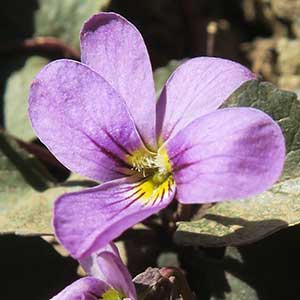Viola flettii
Viola vallicola
Flett's violet, Olympic violet, rock violet
sagebrush violet, valley violet, valley yellow violet, yellow prairie violet, yellow sagebrush violet
1–3, ascending to erect, mostly glabrous, on caudex from fleshy rhizome.
1–5, decumbent or ascending to erect, leafy proximally and distally, ca. 1/2 subterranean, glabrate to puberulent, on caudex from usually vertical, subligneous rhizome.
basal and cauline;
basal: 1–3;
stipules linear-lanceolate, margins entire or with glandular processes, apex acuminate;
petiole 1.5–9.7 cm, mostly glabrous;
blade purple-tinted and –veined, broadly reniform to ovate, 0.9–2.4 × 1.2–4 cm, base cordate, margins finely crenate-serrate, eciliate, apex acute to obtuse, surfaces glabrous or sparsely pubescent along veins adaxially;
cauline similar to basal except: stipules ovate to lanceolate, margins entire or shallowly laciniate;
petiole 0.7–5.9 cm, usually glabrous;
blade 0.8–2.1 × 1.2–3.1 cm.
basal and cauline;
basal: 1–6;
stipules adnate to petiole, forming 2 linear-lanceolate wings, margins entire, apex of each wing free, sometimes divided into filiform processes;
petiole 3–10 cm, glabrous or puberulent;
blade ovate to oblong-ovate, 1.5–4.3 × 0.9–1.1 cm, base usually truncate, sometimes attenuate, margins entire or serrulate, sometimes sinuate, ciliate (sometimes only on proximal 1/2 of leaf), apex acute to obtuse, surfaces glabrous or puberulent;
cauline similar to basal except: stipules linear to linear-lanceolate, margins ± entire, apex acute;
petiole 1.5–9.2 cm;
blade ovate or lanceolate to elliptic, 2.3–4 × 1–2 cm, length ca. 2.2 times width, base usually ± truncate to subcordate, sometimes attenuate on new leaves, margins sinuate, apex acute.
1.8–7.1 cm, usually glabrous.
3–11.5 cm, glabrous or puberulent.
sepals lanceolate, margins eciliate, auricles 0.5–1.5 mm;
petals soft reddish violet on both surfaces, all with yellow area basally, lower 3 dark violet-veined, lateral 2 bearded, lowest with white around yellow area, 10–15 mm, spur yellow, gibbous, 0.5–2 mm;
style head bearded; cleistogamous flowers axillary.
sepals lanceolate, margins eciliate, auricles 0.5–1 mm;
petals deep lemon-yellow adaxially or on both surfaces, upper 2 often brownish purple abaxially, lower 3 dark brown- to brownish purple-veined, lateral 2 sparsely bearded, lowest 9–14 mm, spur yellow, gibbous, 0.8–1.2 mm;
style head bearded; cleistogamous flowers axillary.
± spherical, 5–9 mm, glabrous.
spherical, ca. 5 mm, glabrous or finely puberulent.
dark brown to brownish purple, 2.5–3 mm.
tan, 2.1–2.2 mm, elaiosome extending beyond and covering funiculus.
= 12.
Viola flettii
Viola vallicola
Viola flettii is endemic to the Olympic Mountains of northwestern Washington. C. S. McCreary (2005) noted that although morphologically and ecologically distinct, V. cuneata, V. flettii, and V. ocellata are closely related.
(Discussion copyrighted by Flora of North America; reprinted with permission.)
D. M. Fabijan et al. (1987) distinguished two varieties of Viola vallicola based on geographic location and type of leaf flavonoids: 1) var. major (Hooker) Fabijan, occurring west of the Continental Divide with leaf flavonoids primarily kaempferol derivatives; and 2) var. vallicola occurring east of the Continental Divide with leaf flavonoids all apigenin derivatives. Fabijan et al. reported that var. major (valley violet) occurs in sagebrush flats, prairie grasslands, open forests, juniper woodlands, 400–2800 m, in Alberta, Colorado, Idaho, Montana, Nevada, Oregon, Utah, and Washington.
M. S. Baker (1957) noted that there is only a tendency for leaves of Viola vallicola to be wide with truncate bases; on some plants only a few leaves are truncate. Images of type specimens at NY show truncate leaf bases for most basal and cauline leaves, with only some cauline leaves being attenuate. The key to V. vallicola in D. M. Fabijan et al. (1987) described the cauline leaf bases as truncate with some later cauline leaves becoming cuneate. G. Davidse (1976) stated that the V. vallicola plants he studied had cordate to truncate leaf bases; he made no distinction between basal and cauline leaves. Baker stated that V. vallicola may have given rise to V. nuttallii through a doubling of its chromosomes.
Because intermediate leaf forms are found in areas where Viola vallicola and V. nuttallii are sympatric, some question the specific status of V. vallicola. No hybrids involving V. nuttallii and V. vallicola are known (D. M. Fabijan et al. 1987).
V. Harms (pers. comm.) reported that Viola vallicola is frequent in southern Saskatchewan grasslands, usually occurring with V. nuttallii and appearing the more frequent of the two.
Observed pollinators of Viola vallicola in the intermountain region include flies in the genera Bombylius Linnaeus and Eristalis Latreille (G. Davidse 1976).
(Discussion copyrighted by Flora of North America; reprinted with permission.)


